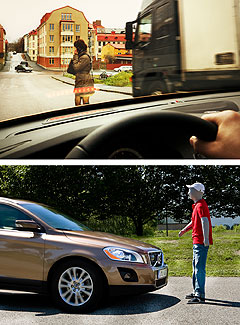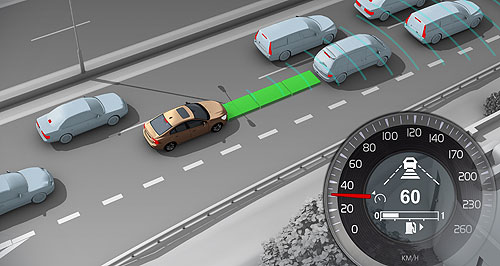News - General NewsHigh-tech safety gadgets to get ANCAP ratingSafety first: New anti-collision technologies such as Mercedes-Benz's car-to-car communication device will be included in a new ANCAP ratings system over the next few years. Latest crash avoidance systems to be included in car safety ratings by ANCAP15 Sep 2010 AUSTRALIA will fall into synch with Europe in ramping up independent car safety ratings tests to measure a plethora of new high-tech safety systems such as blind-spot warning, pedestrian collision avoidance and intelligent speed assist that are beyond the scope of the current five-star ratings. A ‘roadmap’ announced today by the Australian New Car Assessment Program (ANCAP) foreshadows the progressive introduction of the new ratings system, which mirrors a similar program adopted by its sister Euro NCAP organisation. The first new-car ratings under the so-called ‘ENCAP Advanced’ system in Europe are set to be announced at the Paris motor show starting on September 30. In Australia, European premium car importers in particular have been critical of the current standards that award five-star ratings to even the most average cars in Australian showrooms, saying the tests have failed to keep up with the advance of safety technologies in cutting edge cars, particularly in the area of electronic-aided crash avoidance. The details of the ranking system and roll-out calendar are not expected to be locked in until early next year, with ANCAP still discussing the finer points with various stakeholders, including car-makers. The ratings system will be made progressively tougher between 2011 and 2013, as more tests and safety features are included in the four and five-star ratings. The new active safety devices will be accorded a points score, and manufacturers will require a minimum points tally to qualify for the top ranking, getting harder over time. This score could be achieved by ticking the boxes of a variety of different technologies. Only new models on the market will be ranked, and current models will not be re-tested against the new format. Car-makers and importers could, however, claim their new vehicle meets future standards once those standards are spelled out by ANCAP, in the same way that some manufacturers do now with emissions regulations. Unlike the NCAP crash test ratings that have helped to set road safety benchmarks around the world over the past two decades, the new system will not involve a physical test, rather an assessment by experts of data supplied by manufacturers on their latest “safety assist technologies”. ANCAP – which is funded by a consortium of Australian and New Zealand governments, automobile clubs and insurers – said today that the new ratings system would be rolled out in Australia over the next few years to raise crash performance ratings to incorporate pedestrian safety, whiplash protection and roof strength into the overall star rating. “In addition, minimum standards will be set for the progressive inclusion of life-saving safety assist technology including, for example, electronic stability control, daytime running lights, emergency brake assist, collision avoidance, lane departure warnings, driver fatigue systems and intelligent speed assist. “Many of these systems are being introduced by some new car manufacturers and importers, and the new ratings will help new-car buyers, from fleet owners to families, understand and be able to assess the benefits.”  Left: Volvo's pedestrian collision avoidance system will debut on its S60 later this year. Left: Volvo's pedestrian collision avoidance system will debut on its S60 later this year.The NCAP system was established to encourage – or even shame – car-makers into improving crash safety, and was widely criticised by many manufacturers who said its focus was too narrow and not ‘real world’. Now, car-makers are frequently setting the safety pace, forcing NCAP organisations around the world to devise new tests to rate vehicles. Even Australian car-makers are pushing the envelope, with Holden Special Vehicles announcing last week that its Grange luxury performance car will get a blind-spot warning system as standard equipment in the latest facelift. The once frosty relationship between ANCAP and the car companies also appears to have thawed, with the independent test organisation saying it had discussions with the Federal Chamber of Automotive Industries (FCAI) over the past six months to finalise the roadmap to ensure the new safety assessment program would encourage the introduction of safer cars and technologies. Unlike the crash tests, in which ANCAP has frequently bought new cars to crash test them if car-makers would not supply them, the new technologies are reliant on car company engineering data. Leading safety proponents such as Mercedes-Benz, BMW and Volvo are expected to be only too happy to lead the way on supplying data for their new-age technologies, many of which are already available in this country or, like Volvo’s pedestrian anti-collision detection device on its new S60, imminent. Mercedes-Benz Australia senior manager corporate communications David McCarthy told GoAuto that anything that encouraged greater safety and better informed the public on which cars were safer should be welcomed. He said the issue had become clouded with the awarding of five-star ratings to some cars that just scraped into the bracket, while others that were clearly superior had not received any added recognition. “As I say to people, there are five-star hotels and five-star hotels,” he said. Mr McCarthy said Mercedes-Benz hoped to add speed-limit sign recognition technology to its safety armoury from next year. ANCAP chairman Lauchlan McIntosh said the roadmap was part of a continuing process to encourage early introduction of vehicle safety features to make cars safer for Australian motorists and their families. “The ANCAP roadmap takes its lead from the recent rating system changes introduced by Euro NCAP, and ensures a continuation of ANCAP’s relationship with EuroNCAP and improved harmonisation of rating systems,” he said. “We are pleased that there has been acceptance from the FCAI and the automotive industry in recognising the value of ANCAP testing and results. “ANCAP is also working with its crash testing colleagues in Japan, Korea, China, USA and Malaysia to further improve vehicle safety around the world.” Mr McIntosh said ANCAP was continuing to grow in its role as the independent vehicle safety advocate, and cited increasing industry promotion of the ANCAP ratings in advertising campaigns, the mandating of electronic stability control (ESC) by the federal government, and the recent $5 million, five-year partnership with the commonwealth to increase the number of crash tests and the level of research into vehicle safety. “We will continue to work closely with governments, industry and the media to promote vehicle safety and the crash test ratings to new car buyers, and we look forward to further collaboration with many stakeholders on safety project and activities,” he said. In June, the federal government anounced a $5 million grant over four years to enable ANCAP to almost double the number of crash tests it performs each year, from 10 to 15 to around 25 tests. Among the new technologies that are reshaping road safety are lane departure warning, attention assist, autonomous braking, car-to-car communication and emergency call. Says ENCAP: “Many of the technologies are so new that no accepted standards exist to assess them. “Euro NCAP has developed a unique methodology which allows the potential safety benefits of any new technology to be determined.” How the new ratings system will provide guidance to consumers on the value of these systems is yet to be seen in practice, but safety experts hope the publicity afforded to the best of the new systems on top-shelf luxury cars will provide an incentive to manufacturers to accelerate the standard fitment of important safety equipment across their entire model ranges. Meanwhile, China’s NCAP organisation – C-NCAP – announced this week that it too would improve its safety test standards.  Read more |
Click to shareGeneral News articlesResearch General News Motor industry news |
















Facebook Twitter Instagram